
Philadelphus lewisii, the Lewis' mock-orange, mock-orange, Gordon's mockorange, wild mockorange,Indian arrowwood, or syringa, is a deciduous shrub native to western North America, and is the state flower of Idaho.

Sida fallax, known as yellow ilima or golden mallow, is a species of herbaceous flowering plant in the Hibiscus family, Malvaceae, indigenous to the Hawaiian Archipelago and other Pacific Islands. Plants may be erect or prostrate and are found in drier areas in sandy soils, often near the ocean. ʻIlima is the symbol of Laloimehani and is the flower for the islands of Oʻahu, Hawaiʻi, and Abemama, Kiribati.

Balsamorhiza is a genus of plants in the family Asteraceae known commonly as balsamroots. These are perennials with fleshy taproots and caudices bearing erect stems and large, basal leaves. Atop the tall stems are showy yellow sunflower-like blooms. Balsamroots are native to western North America.
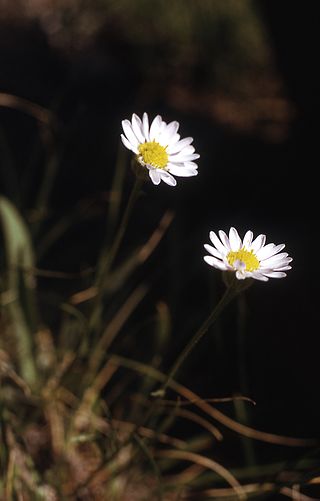
Erigeron eatonii is a North American species of flowering plants in the family Asteraceae known by the common name Eaton's fleabane.
Eryngium constancei is a species of flowering plant in the family Apiaceae known by the common name Loch Lomond button celery, or Loch Lomond coyote thistle. It is endemic to California, where it is known from only three occurrences north of the San Francisco Bay Area. One of the populations is at the Loch Lomond Vernal Pool Ecological Reserve at Loch Lomond in Lake County. The plant appears mainly in vernal pools. It is endangered on the state and federal levels.

Senecio triangularis, known as arrowleaf ragwort, arrowleaf groundsel and arrowleaf butterweed, is a species of the genus Senecio and family Asteraceae.
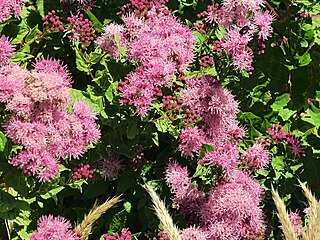
Ageratina occidentalis is a species of flowering plant in the family Asteraceae known by the common name western snakeroot or western eupatorium. It is native to the western United States where it grows in several types of habitat. It is found in California, Oregon, Washington, Idaho, Montana, Nevada, and Utah.

Cirsium scariosum is a species of thistle known by the common names meadow thistle, elk thistle and dwarf thistle. It is native to much of western North America from Alberta and British Columbia, south to Baja California. There are also isolated populations on the Canadian Atlantic Coast, on the Mingan Archipelago in Québec, where it is called the Mingan thistle.

Penstemon stephensii is an uncommon species of penstemon known by the common name Stephens' beardtongue, or Stephens' penstemon. It is endemic to California, where it is known only from the mountains of the Mojave Desert region. It grows in scrub, woodland, and sandy clearings, often on limestone substrates. It is an erect shrub which may reach 1.5 meters in height, with many leafy flowering stems. The thin leaves are oval with wide triangular tips and serrated edges. The oppositely arranged pairs fuse about the stem at the bases, sometimes forming a disc. The inflorescence bears glandular, wide-mouthed tubular flowers up to 2 centimeters long in shades of pink or purple. The plant is pollinated by hummingbirds.

Petalonyx nitidus is a species of flowering plant in the family Loasaceae known by the common name shinyleaf sandpaper plant. It is native to the deserts and desert mountains of the southwestern United States, where it grows in scrub, woodland, and other habitat. It is a clumpy subshrub made up of many rough-haired, erect or spreading stems growing 15 to 45 centimeters long. The leaves are oval, pointed, usually toothed or serrated, and up to 4 centimeters long. The inflorescence at the end of the stem is a crowded raceme of many flowers. The flower appears tubular, its white petals fused near the spreading tips but open lower, the long stamens extending well beyond the corolla, and unusual in that they emerge from outside the corolla.

Phlox diffusa is a species of phlox known by the common name spreading phlox. It is native to western North America from British Columbia to the southwestern United States to the Dakotas, where it grows in many types of habitat, including rocky, high elevation mountain slopes. It is a very compact mat-forming perennial herb growing in cushions or patches of short, decumbent stems. The linear, lance-shaped, or needle-like leaves are no more than 1.5 centimeters long and are oppositely arranged in bundles on the short stems. The inflorescence is a solitary tubular flower around a centimeter long. It has a flat white or pale pink or blue corolla with five lobes each just under a centimeter in length.
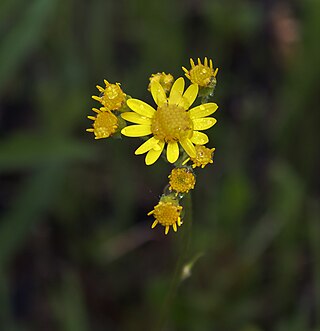
Packera pseudaurea is a species of flowering plant in the aster family known by the common name falsegold groundsel. It is native to North America, where it can be found in western and central parts of Canada and the United States. It grows in mountain habitat such as meadows, streambanks, and woodlands.
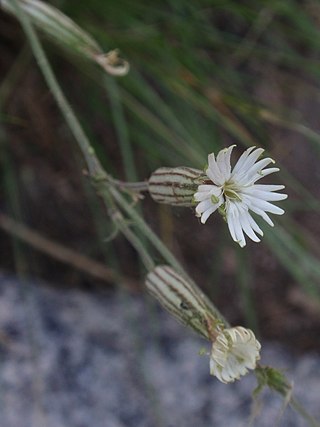
Silene bernardina is a species of flowering plant in the family Caryophyllaceae known by the common name Palmer's catchfly.
Silene suksdorfii is a species of flowering plant in the family Caryophyllaceae known by the common names Suksdorf's silene, Suksdorf's catchfly and Cascade alpine campion. It is native to the Pacific Northwest of the United States, where it occurs from Washington and Idaho to northern California. It is mainly an alpine species, growing in the talus of high mountain slopes. It can also be found below the tree line in forested subalpine habitat. It is a squat perennial herb producing several erect stems from a leafy, woody caudex. It generally takes a clumpy form. The stems grow up to 10 or 15 centimeters tall and are hairy in texture, with glandular, sticky areas on the upper parts. The leaves occur in tufts around the caudex. They are fleshy and coated in soft hairs. Solitary flowers arise on erect peduncles. Each is encapsulated in an inflated calyx of fused sepals, which is starkly purple-veined and has purplish glandular hairs. The petals are white or purple-tinged and have two lobes at their tips and appendages at their bases.

Solidago multiradiata is a species of goldenrod known by the common names Rocky Mountain goldenrod, northern goldenrod, and alpine goldenrod. It is native to North America, where it can be found throughout the northern regions, including Alaska and most of Canada (all 3 territories plus all provinces except Prince Edward Island, including territory north of the Arctic Circle. Its distribution extends through the western United States as far south as Arizona, New Mexico, and California. It is known mostly from the subalpine and alpine climates of high mountain ranges. Its habitat includes tundra and mountain meadows.

Spiranthes porrifolia is a species of orchid known by the common names creamy lady's tresses and western ladies' tresses. It is native to the western United States from Washington and Idaho to southern California. It can be found in moist habitats, such as mountain meadows, swamps, fens, and riverbanks. It is a perennial herb growing from a tuberous root system, reaching a maximum height around 60 cm (24 in). The leaves are mainly located around the base of the erect stem. They are linear or lance-shaped, or sometimes nearly oval. The top of the stem is occupied by the inflorescence, a dense spiral of many flowers. Each flower is somewhat tubular, with an upper and lower lip, and cream to yellowish in color.
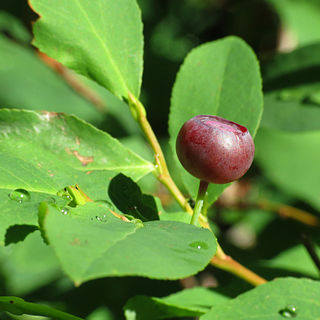
Vaccinium membranaceum is a species within the group of Vaccinium commonly referred to as huckleberry. This particular species is known by the common names thinleaf huckleberry, tall huckleberry, big huckleberry, mountain huckleberry, square-twig blueberry, and (ambiguously) as "black huckleberry".

Veronica peregrina is a species of flowering plant in the plantain family known by several common names including neckweed, American speedwell, purslane speedwell and hairy purslane speedwell. It is native to the Americas, and is known on other continents as an introduced species and a common weed. It can be weedy in its native range as well, growing on roadsides, on fields, and in other disturbed habitat. It is an annual herb growing from a taproot. The two subspecies are defined generally on the basis of hairiness: ssp. xalapensis is coated in glandular hairs and ssp. peregrina is a hairless variety. The plant produces erect stems up to about 30 centimeters tall. The leaves vary in shape from linear to lance-shaped to spoon-shaped with smooth or serrated edges; the lower leaves are borne on petioles. The inflorescence is a loose terminal raceme of flowers and lance-shaped bracts. The flowers are generally white and 2 or 3 millimeters wide.
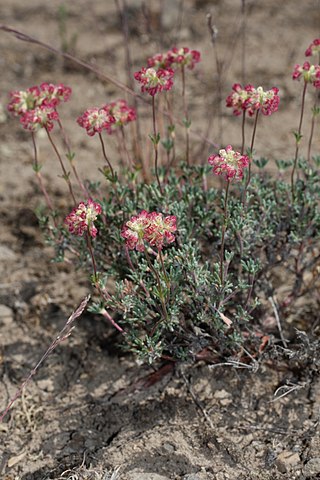
Eriogonum thymoides is a species of flowering plant in the buckwheat family known by the common name thymeleaf wild buckwheat, or simply thymeleaf buckwheat.
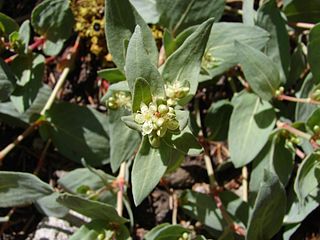
Koenigia davisiae is a flowering plant in the knotweed family that is known by the common names Davis' knotweed or Newberry knotweed.

















